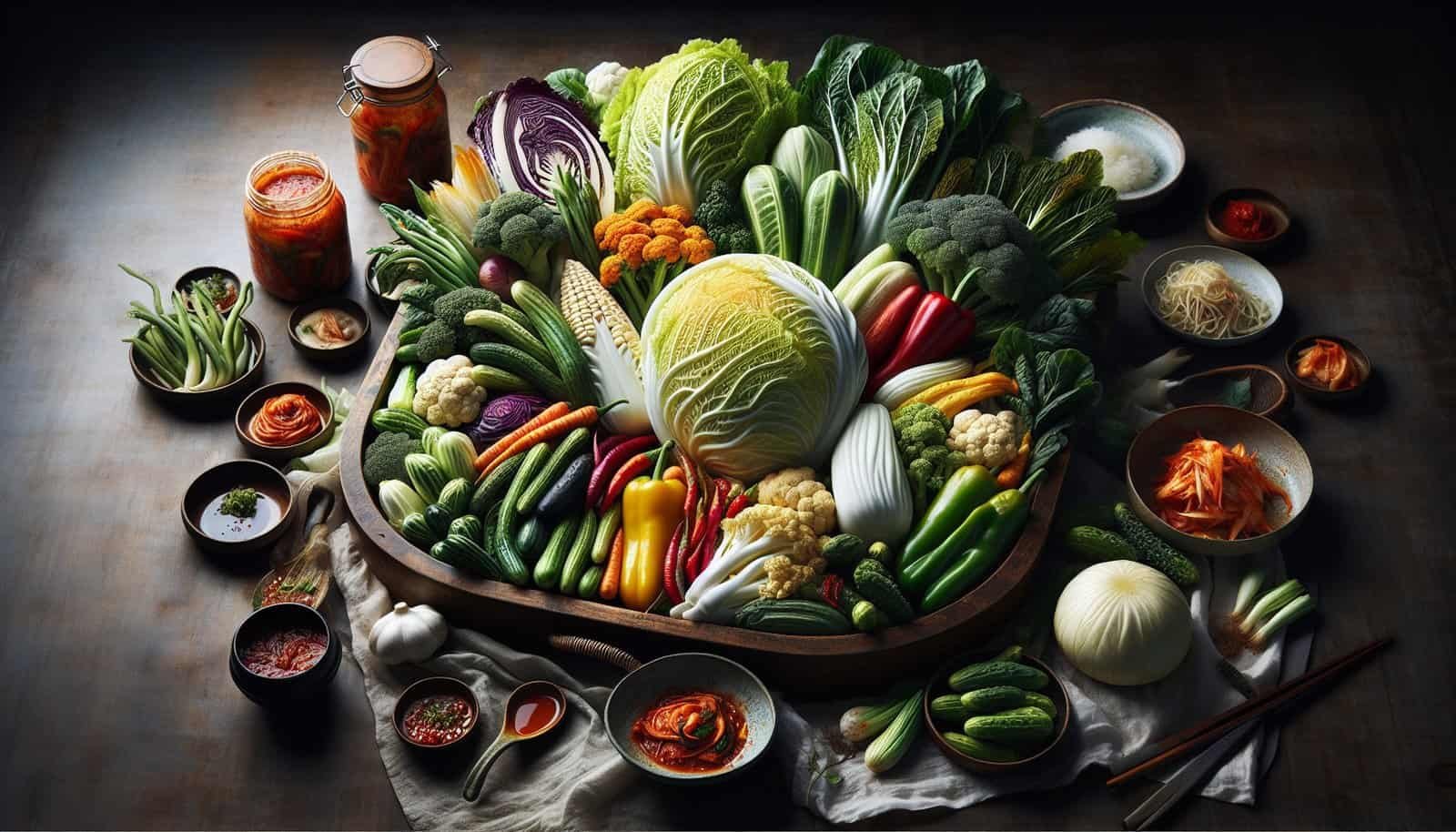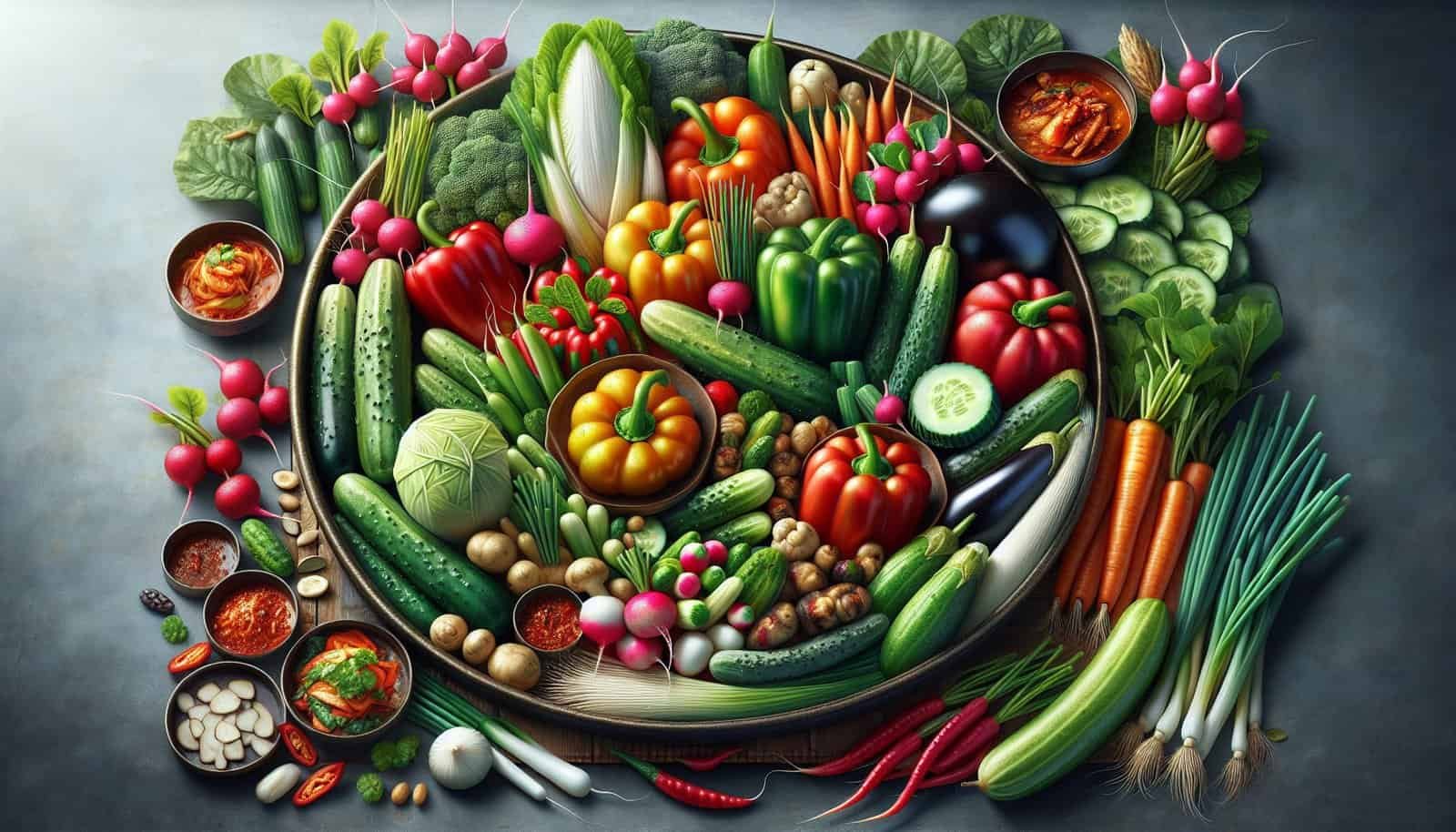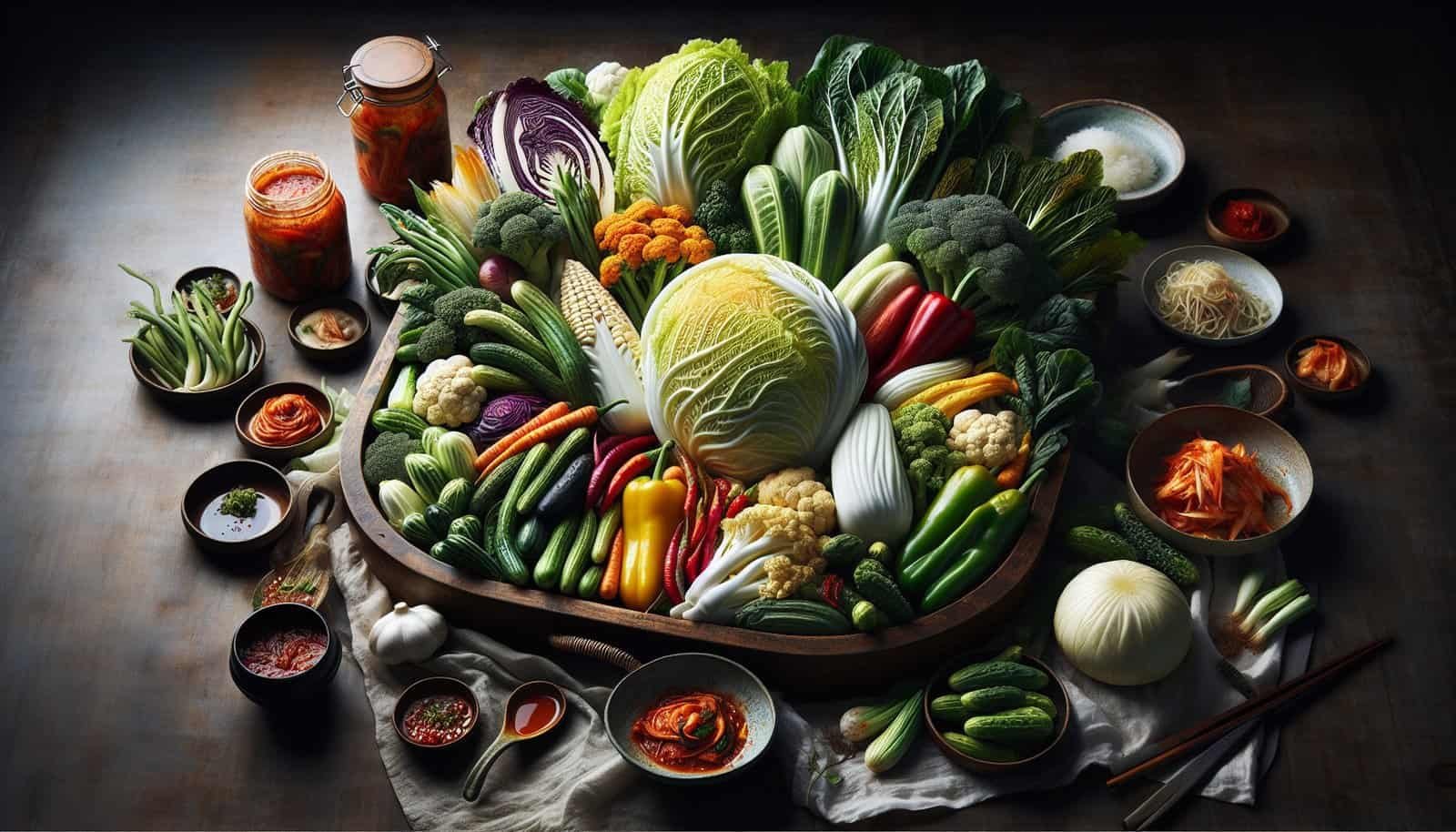In Korean cooking, the use of seasonal ingredients is essential to creating delicious and authentic dishes. From fresh, crisp vegetables to flavorful seafood, Korean cuisine celebrates the natural flavors that come with each changing season. The vibrant and diverse landscape of Korea provides an abundance of ingredients throughout the year, allowing for a wide variety of dishes to be enjoyed at different times. Whether it’s the spicy chili peppers of summer or the hearty root vegetables of winter, each season brings its own unique flavors to the Korean table. Discover the seasonal ingredients that are central to Korean cooking and elevate your culinary experience with the vibrant tastes of Korea.

Root Vegetables
Daikon
Daikon is a type of root vegetable that is commonly used in Korean cooking. It has a mild, sweet flavor and a crisp texture. Daikon is often added to soups, stews, and pickles, providing a refreshing and slightly tangy taste. It is also used as a garnish for various dishes, adding a crunchy element. With its versatility and distinct flavor, daikon is an essential ingredient in many Korean recipes.
Lotus Root
Lotus root is another root vegetable that plays a central role in Korean cuisine. It has a unique taste and texture, with a mild sweetness and a crisp, crunchy texture. Lotus root is often used in stir-fries and side dishes, bringing a refreshing and earthy flavor to the dish. It can also be thinly sliced and added to soups and stews, enhancing the overall flavor and providing a delightful crunch. In addition to its culinary uses, lotus root is also praised for its health benefits, as it is rich in dietary fiber and essential nutrients.
Burdock
Burdock is a root vegetable that is widely used in Korean cuisine for its distinct flavor and medicinal properties. It has a mild, earthy taste and a crunchy texture. Burdock is commonly used in soups, stir-fries, and braised dishes, imparting a unique flavor and adding a delightful crunch. It is also known for its detoxifying properties and is often used in traditional Korean medicine to cleanse the body. In Korean cooking, burdock is considered a staple ingredient and is loved for its versatility and health benefits.
Carrots
Carrots are a staple vegetable in Korean cuisine, adding vibrant color and a sweet, earthy flavor to dishes. They are commonly used in soups, stir-fries, and side dishes, providing a natural sweetness and a satisfying crunch. Carrots are also used as a garnish, adding a pop of color and enhancing the visual appeal of the dish. They are not only delicious but also packed with essential nutrients and vitamins, making them a healthy choice for any Korean meal.
Leafy Greens
Spinach
Spinach is a popular leafy green vegetable that is widely used in Korean cooking. It has a delicate flavor and tender texture, making it a versatile ingredient in various dishes. Spinach is often blanched and seasoned with soy sauce and sesame oil to create a simple yet delicious side dish called “sigeumchi namul.” It is also used in soups, stews, and savory pancakes, adding a vibrant green color and a nutritious boost. With its abundance of vitamins and minerals, spinach is a must-have ingredient in Korean cuisine.
Napa Cabbage
Napa cabbage, also known as Chinese cabbage, is a key ingredient in Korean cuisine, especially for making kimchi. It has a mild, slightly sweet taste and a crunchy texture. Napa cabbage is traditionally fermented with various seasonings, creating the iconic and flavorful kimchi that is a staple in Korean households. Apart from kimchi, napa cabbage is also used in stir-fries, soups, and stews, bringing a refreshing and crisp element to the dishes. Its versatility and nutritional value make it a beloved ingredient in Korean cooking.
Perilla Leaves
Perilla leaves, also known as sesame leaves, are commonly used in Korean cuisine for their distinctive flavor and aroma. They have a slightly minty, herbal taste and a tender, velvety texture. Perilla leaves are often used as a wrap for grilled meat, adding a delightful crunch and a unique flavor to each bite. They can also be used as a garnish, adding a pop of green color and a refreshing aroma to various dishes. With their subtle yet impactful flavor, perilla leaves are an essential herb in Korean cooking.
Fermented Ingredients
Kimchi
Kimchi is perhaps the most iconic Korean fermented ingredient, and it is an integral part of Korean cuisine. Made primarily from napa cabbage, radishes, and other vegetables, kimchi is traditionally prepared by fermenting the ingredients with various spices and seasonings. The result is a flavorful and tangy dish that is enjoyed as a side dish, a condiment, or even as a main dish in many Korean meals. Kimchi is cherished for its umami taste, crunchy texture, and the health benefits it provides through the fermentation process.
Soy Sauce
Soy sauce is a staple condiment in Korean cooking, adding depth and complexity to dishes. It is made by fermenting soybeans, wheat, and salt, resulting in a dark, savory sauce. Soy sauce is used as a base for marinades, dipping sauces, and stir-fries, bringing a rich flavor and a hint of saltiness to the dish. Its versatility and ability to enhance the taste of various ingredients make soy sauce an essential ingredient in Korean cuisine.
Gochujang
Gochujang is a spicy fermented chili paste that is widely used in Korean cuisine. It is made from red chili peppers, glutinous rice, fermented soybeans, and salt. Gochujang is often used as a seasoning and a condiment, adding a spicy kick and a rich umami flavor to dishes. It is a key ingredient in iconic Korean dishes such as bibimbap and tteokbokki, providing a distinctive taste and a vibrant red color. Gochujang is loved for its complex flavors and the depth it brings to Korean cooking.
Seafood
Short-necked Clams
Short-necked clams, also known as Manila clams, are a popular seafood ingredient in Korean cuisine. They have a slightly sweet and briny taste, with tender meat that is prized for its texture. Short-necked clams are often used in soups, stews, and stir-fries, infusing the dish with their rich and flavorful broth. They are also commonly enjoyed steamed or grilled, bringing a taste of the ocean to the Korean table. With their versatility and delicious flavor, short-necked clams are a beloved ingredient in Korean seafood dishes.
Mussels
Mussels are another type of shellfish that are widely enjoyed in Korean cooking. They have a mild and slightly sweet taste, with tender meat that is prized for its delicate texture. Mussels are often used in soups, stews, and seafood pancakes, providing a rich and briny flavor to the dish. They can also be enjoyed steamed or grilled, allowing their natural flavor to shine. With their abundance of nutrients and unique taste, mussels are a delightful addition to Korean seafood dishes.
Anchovies
Anchovies are a small, oily fish that play a central role in Korean cuisine. They are commonly used in the form of dried and fermented fish sauce called “myeolchi aekjeot,” providing a distinct umami flavor to various dishes. Anchovies are used to make broth for soups and stews, adding depth and richness to the dish. They are often served alongside rice as a side dish, providing a salty and savory element to the meal. Anchovies are highly valued for their intense flavor and the umami boost they bring to Korean cooking.

Mushrooms
Shiitake
Shiitake mushrooms are a prized ingredient in Korean cuisine, known for their rich and meaty flavor. They have a slightly earthy taste and a chewy texture, making them a satisfying addition to many dishes. Shiitake mushrooms are often used in soups, stir-fries, and side dishes, bringing an umami punch to the dish. They can also be dried and rehydrated, intensifying their flavor and adding depth to broths and sauces. With their versatility and delightful taste, shiitake mushrooms are a beloved ingredient in Korean cooking.
Enoki
Enoki mushrooms, with their delicate and slim appearance, are a popular ingredient in Korean cuisine. They have a mild, slightly sweet taste and a crisp texture, adding a refreshing element to dishes. Enoki mushrooms are commonly used in stir-fries, soups, and hot pots, enhancing the overall flavor and providing a pleasing crunch. They can also be enjoyed raw in salads, adding a unique visual appeal and a subtly sweet taste. With their versatility and delicate flavor, enoki mushrooms are a cherished ingredient in Korean cuisine.
King Oyster
King oyster mushrooms, also known as king trumpet mushrooms, are highly valued in Korean cooking for their meaty texture and umami flavor. They have a mild and slightly sweet taste, with a chewy and firm texture that stands up well in various dishes. King oyster mushrooms are often used in stir-fries, braised dishes, and hot pots, absorbing the flavors of the seasonings and adding richness to the dish. They can also be grilled or roasted, bringing out their natural sweetness and enhancing their umami taste. With their versatility and unique texture, king oyster mushrooms are an essential ingredient in Korean cuisine.
Fruits
Persimmons
Persimmons are a beloved fruit in Korean cuisine, especially during the fall season. They have a sweet and slightly tangy taste, with a soft and fleshy texture. Persimmons are often enjoyed fresh as a snack, dessert, or added to salads for a burst of sweetness. They can also be dried and used as a flavoring in teas or in traditional Korean desserts. With their vibrant color and refreshing taste, persimmons are a delightful addition to Korean meals.
Pears
Pears are a popular fruit in Korean cuisine, valued for their juicy and refreshing flavor. They have a sweet and slightly floral taste, with a crisp texture that adds a delightful crunch to dishes. Pears are often enjoyed fresh as a snack, added to salads, or used as a natural sweetener in savory dishes. They are also commonly used in Korean traditional medicine for their cooling properties and digestive benefits. With their versatility and natural sweetness, pears are a delicious and healthy choice for Korean cooking.
Apples
Apples are a versatile fruit that finds its way into many Korean dishes, providing a sweet and slightly tart flavor to various dishes. They are enjoyed fresh as a snack or used in salads and desserts, adding a refreshing and crisp element. Apples can also be cooked down to create a sweet and tangy sauce, which is often used as a glaze or a marinade for meats. With their abundance of vitamins and natural sweetness, apples are a delightful fruit to incorporate into Korean cooking.

Grains
Rice
Rice is a staple grain in Korean cuisine and forms the foundation of many meals. It is traditionally enjoyed as a steamed or boiled side dish, providing a neutral and comforting taste. Rice is also used to make various dishes such as bibimbap, fried rice, and rice cakes, incorporating other ingredients and flavors. It is a versatile grain that pairs well with other Korean dishes, serving as a base to soak up the flavors of the main ingredients. With its essential role in Korean cuisine, rice is a fundamental ingredient that is enjoyed in many forms.
Barley
Barley is another grain that is commonly used in Korean cooking, providing a nutty and slightly chewy texture. It is often mixed with rice to create a healthier and more nutritious meal. Barley adds depth and a pleasant texture to rice dishes, creating a filling and satisfying meal. It is also used in stews and soups, providing a hearty element to the dish. With its high fiber content and unique taste, barley is a popular grain in Korean cuisine.
Sweet Rice
Sweet rice, also known as glutinous rice, is a type of rice that has a sticky and chewy texture when cooked. It is used in Korean cuisine to make a variety of dishes, most notably rice cakes or “tteok.” Sweet rice is soaked, ground, and then shaped into different forms, such as round balls or flat slices. These rice cakes are then used in various traditional desserts or savory dishes, showcasing the versatility and unique texture of sweet rice. With its sticky and satisfying taste, sweet rice is an essential ingredient in Korean cooking.
Nuts and Seeds
Pine Nuts
Pine nuts are a prized ingredient in Korean cuisine, highly valued for their buttery and rich flavor. They are often used as a garnish, adding a delightful crunch and a nutty taste to dishes. Pine nuts can be used in various traditional Korean dishes such as cold noodles, spinach salad, or tossed with rice. They can also be toasted and ground to create a paste or a sauce, providing a sophisticated flavor and texture to the dish. With their unique taste and versatility, pine nuts are a cherished ingredient in Korean cooking.
Sesame Seeds
Sesame seeds are a staple ingredient in Korean cuisine, offering a nutty and slightly sweet taste. They are used as a garnish, providing a delightful crunch and a distinct flavor to dishes. Sesame seeds are often toasted and ground to create a seasoning called “gireumjang,” which is used as a dipping sauce or a marinade for grilled meat. They can also be ground into a paste to make sauces and dressings, adding a rich and aromatic flavor. With their versatility and unique taste, sesame seeds are an essential ingredient in Korean cooking.
Chestnuts
Chestnuts are a popular nut in Korean cuisine, known for their sweet and slightly earthy flavor. They are often used in both sweet and savory dishes, adding a unique taste and a delightful texture. Chestnuts are commonly used in desserts, such as rice cakes or “songpyeon,” providing a nutty and creamy filling. They can also be used in stews, rice dishes, and side dishes, bringing a rich and hearty element to the dish. With their distinct taste and versatility, chestnuts are a beloved ingredient in Korean cooking.

Fruits and Vegetables for Fermentation
Radishes
Radishes are commonly used in Korean cuisine for their crunchy texture and mild, slightly tangy taste. They are often used in various forms of kimchi, including the iconic “kkakdugi” or cubed radish kimchi. Radishes are also pickled and fermented to create a refreshing side dish called “gakdugi,” which is a popular accompaniment to many Korean meals. With their ability to add a refreshing and tangy taste to dishes, radishes are an essential ingredient for fermentation in Korean cooking.
Cucumbers
Cucumbers are another popular vegetable for fermentation in Korean cuisine. They have a crisp texture and a mild, refreshing taste. Cucumbers are often pickled and fermented to create a side dish called “oi kimchi” or cucumber kimchi, which is loved for its crunchy texture and tangy flavor. This fermented cucumber dish is commonly enjoyed alongside rice and other Korean dishes, providing a refreshing and tasty contrast. With their ability to transform into an entirely new dish through fermentation, cucumbers are a beloved ingredient in Korean cuisine.
Chili Peppers
Chili peppers are a key ingredient for fermentation in Korean cuisine, adding a spicy kick and vibrant color to various dishes. They are commonly used to make kimchi, both in the form of whole peppers and as chili powder or “gochugaru.” Chili peppers are dried, ground, and fermented to create a distinctively spicy and flavorful kimchi that is a staple in Korean households. They can also be used in various other dishes to add heat and depth of flavor. With their ability to elevate the taste and appearance of Korean dishes, chili peppers are an essential ingredient for fermentation.
Others
Acorns
Acorns are a unique ingredient in Korean cuisine, often used in traditional dishes and desserts. They have a slightly bitter taste and a rich, nutty flavor that adds depth to the dish. Acorns are traditionally pounded into a fine powder and used as a flour substitute to make noodles or bread. They can also be roasted, crushed, or ground to create a paste or a sauce for both sweet and savory dishes. With their distinctive taste and historical significance, acorns are an intriguing ingredient in Korean cooking.
Sea Vegetables
Sea vegetables, also known as seaweed or “gim” in Korean, play a significant role in Korean cuisine. They are a rich source of vitamins and minerals and are consumed in various forms. Sea vegetables are often used as a wrap for rice or other ingredients, creating popular dishes such as “gimbap” or seaweed rice rolls. They can also be used as a seasoning or a garnish for soups, stews, and side dishes, adding a unique umami flavor and a touch of oceanic taste. With their nutritional value and distinct flavor, sea vegetables are a cherished ingredient in Korean cooking.
Mugwort
Mugwort is an herb that is used in Korean cuisine for its unique taste and health benefits. It has a slightly bitter and earthy flavor, with a hint of sweetness. Mugwort is often used in rice cakes, soups, and teas, adding a distinctive aroma and a healthful element to the dish. It is also considered a medicinal herb in traditional Korean medicine, known for its anti-inflammatory and detoxifying properties. With its versatile uses and potential health benefits, mugwort is an intriguing ingredient in Korean cooking.
In conclusion, Korean cuisine is rich in seasonal ingredients that are central to its unique and flavorful dishes. Whether it’s root vegetables, leafy greens, fermented ingredients, seafood, mushrooms, fruits, grains, nuts and seeds, fruits and vegetables for fermentation, or other unique ingredients, each plays a significant role in creating the diverse flavor profiles that make Korean cooking so beloved. These seasonal ingredients not only provide taste and texture but also carry cultural and historical significance. So the next time you’re exploring Korean cuisine, be sure to savor the flavors of these seasonal ingredients and experience the depth and variety they add to each dish.

